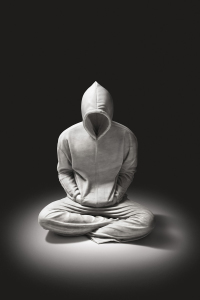 The Soloist by Alex Seton
The Soloist by Alex Setonby Kara-Leah Grant, Musings from the Mat
I’ve been contemplating the many reactions I received to this article over the past week or so, On the Dilution of the Transmission of Yoga.
One person unsubscribed from the website (or at least – one person told me they had because of this article, more people may have!) saying that I had made some good points but she found the article judgemental and unyogic.
Other people rejoiced that someone was speaking such things out loud.
It does feel like a conversation that needs to be had – not to condemn or shame any yoga teachers, but to assess what the current state of teaching is and ask ourselves what needs to be done, how we’re going to do it and who needs to do it.
Because, while it does seem that many yoga teachers are not teaching yoga at all, we are in a position where the sheer numbers of yoga teachers mean there is an opportunity for more yoga than ever before to be shared.
Before I go into some possible actions the yoga community could look at, I want to define what it means to teach yoga.
Yoga is not asana. It is not postures. Yoga is a state of being – it is presence. It is that place where we reside primarily in awareness. There is still thought and there are still feelings yet they are contained within a field of awareness – one is no longer identified with those thoughts or those feelings.
The practice of yoga is the practice of this state of being – the practice of Waking Up, becoming conscious. Ultimately, this leads to self-realization – which is Yoga.
The teaching of yoga is the art of bringing of presence into a room, it is when the teacher is no longer primarily identified with their thoughts and feelings, but can feel and abide in that state of awareness. They don’t have to be completely self-realized or enlightened, but they do need to be able to hold a state of presence.
Asana and postures play an important role in the development of awareness because they give us something to work with. We come to the mat and we move our bodies through postures honing our awareness of our experience, learning to witness our thoughts and stay with our feelings, as uncomfortable as they might be.
This kind of teaching is happening. It happened in Wellington recently at a Tara Judelle workshop. She’s awesome. She’s present. And she’s grounded in all things Yoga – not just asana. I felt like there was a transmission of being happening just by being in the room with her, while we also happened to play with some postures and ways of moving in posture.
This experience gave me hope, because Tara is travelling the world teaching from Presence. She’s not the only one either. Donna Farhi has extraordinary presence, as does Shiva Rea. I know there are many more – I just haven’t made it to their classes yet.
But what about the rest of us? What about people who have just graduated from a 200 hr training? What about people who havce predominantly trained in asana and don’t even know that teaching Yoga means being present?
For the rest of us, I have three words.
Home yoga practice.
That’s it.
I’m not talking about practicing at home to a DVD, or to an online yoga class. I’m talking about home yoga practice that involves you, and only you. And of course, your breath and your awareness.
This is one major piece of the puzzle when it comes to being a yoga teacher. You must have a daily home practice.
I’m going to say that again because it’s so very important.
If you teach yoga, you must have a daily home yoga practice.
It’s non-negotiable. It’s the price of admission. It’s the fuel for your fire. It’s the thing that gives you something to teach. Without a home practice, all you’re doing is memorising postures and anatomy cues and passing on some intellectual knowledge.
But before you freak out about what that means, consider this.
Home yoga practice can be a myriad of things from asana and pranayama to meditation and chanting.
At it’s most basic, it is the practice of being present in all moments – while you’re at work, while you’re parenting, while you’re fighting with your partner, while you’re commuting, while you’re exercising.
However, until you become established in a certain level of awareness, the best way to practice being present is on your mat. Often it’s asana, sometimes it’s meditation. Pranayama and chanting can also be very powerful ways to shift your consciousness.
This is the dedication required to be a teacher. You get on your mat. You do your practice. Every single day.
And if this is difficult… hell, who am I kidding? Of course this is difficult! It’s difficult for anyone and everyone, until you reach a point when it’s not. But until then, you are actively working with the obstacles of your mind in cultivating your home yoga practice – the cultivating of the practice becomes the practice itself.
But if this is too difficult for you – if you can’t practice some kind of yoga, for at least ten minutes, every single day – then you need to ask yourself how committed you are to being a yoga teacher. And how committed you are to your students.
Yes, practicing daily is difficult and challenging. But I’ll say it again – it’s the price of admission. You want to teach yoga? You need to practice yoga. By. Your. Self. Not just classes, not just workshops, not just retreats. Time on your mat, by yourself.
This I know all about – I’ve written an entire book on it. A book that I was surprised to find was incredibly popular with other yoga teachers.
Wait – don’t yoga teachers already have a daily home practice? Why do they need my book?
Well, turns out, many teachers don’t have a daily practice and they don’t know how to establish one, how to work with the challenges and obstacles that come up or understand why it’s so important.
Which brings me around to me next point.
In all those teacher trainings happening around the globe, I haven’t yet seen one that emphasises the necessity of having a home yoga practice, nor coaches teacher trainees on how to develop and maintain a practice.
It seems to be a given, or just assumed that:
A) teacher trainees already have a practice
B) they know how vital is it
C) they will just make it happen.
Not so.
My challenge to anyone holding yoga teacher trainings is to start incorporating sessions on the importance of a home yoga practice and how to create and maintain one through the challenges of modern life. (Need help with this? Contact me.)
Why?
Because helping trainee teachers embed a home practice into their life could be one of the most important things we do to lift the standard of yoga teachers around the world.
And, I would even go a step further.
At a yoga teacher training, I would add a daily session in – it would only need to be half an hour – where trainees come together in the same space and do their home practice. Whatever it is. If a training is held over three weeks, then that gives 21 days of consistent home practice – it’s a start.
But there’s more.
I would also make it clear at these teacher trainings that developing one’s own deep abiding presence is the key to being an effective yoga teacher.
Of course, the only people that can deliver this particular session would be those who can step into that deep abiding presence themselves. This is when yoga teacher trainings might need to be bold and invite outside guests to hold this particular session – which is tricky, because it’s admitting that the teacher who is training the trainees isn’t there yet themselves… but that’s ok!
We’re all in this together. We’re all learning together. Reaching out to those who are deeply present and asking them to hold one session would be a bold and powerful move to make.
So who is present? There’s the big names – the awakened ones like Adyashanti, Mooji, Eckhart Tolle, Ram Dass. But there are others too – I’ve already mentioned some teachers I’ve studied with who I experienced as present. There are more.
Being in the same room as someone who is deeply present invites presence to arise in others. That is the transmission of yoga. That is the transmission of Being. That is the transmission of awakening.
In the wake of the last week of my life, a few keys things have happened – one being attending Tara Judelle’s workshop. As a result of these key happenings I’m deeply certain that it’s possible for the yoga community as a whole to wake up to the importance of teachers who are present and teaching from the abiding place of awareness.
It feels to me like there is a collective awareness that we’re skimming over the surface and not quite doing what we seem to be doing.
That yoga appears to be being taught, but it’s not being transmitted.
That people want that transmission.
They want to slide into awareness and into beingness. They want teachers that invite this in.
It feels like those who are teaching want to be those teachers – they too want to be in a deeper place of awareness and being. They want to teach from those places. But they don’t quite know how.
I don’t quite know how to collectively shift yoga teachers towards greater presence either.
But I suspect that, like anything, simply bringing awareness to what is – the dilution of the transmission of yoga – creates curiosity and openness for the exploration of actions. Actions like:
1. A greater emphasis in the yoga world on daily home yoga practice for teachers
2. More dedicated support for teacher trainees on developing a daily home yoga practice.
And it feels like out of that exploration of possible actions something else might arise.
All it ever takes is a willingness,
A desire
An awareness.
Curiosity,
And the courage to move into the unknown.
What would happen if every teacher who is teaching yoga dedicated themselves to daily home yoga practice?
What would happen if every yoga teacher training programme made it a key priority to help trainees establish a daily home yoga practice?
What would happen if every yoga teacher training programme made sure someone of abiding presence delivered at least one or two sessions?
What would happen?


This article is just self promotion “I’ve written an entire book about it, that is incredibly popular with other yoga teachers”. I have done many workshops with “famous celebrity teachers” including the ones you mention and I did not have the same experience you did at all, I must prefer genuine authenticity and humility, a kindness that shines from the heart. Yoga practice is a lifestyle it’s not something that you do, it’s what you are. Yoga was fine before the western world destroyed it with over inflated egos. Who are you to tell teachers what they “should” be doing? Some of the best teachers I’ve had have taught me more about yoga just by the way they are, not what they do.
Hey Lesley,
I’m sitting here reading and rereading your comment pondering how to respond. Yes, there is synergy between the idea that yoga teachers need to have some kind of home yoga practice – whether it’s asana, pranayama, mindful living, reading yogic texts or chanting or whatever other way they’re approaching yoga – and the process that I’ve found useful for embedding yoga into daily life. If the book I wrote is useful, great, if not, it doesn’t matter. This isn’t promotion of my-Self at all – simply a process that may or may not be of use.
The fascinating aspect of life is that two people can experience the same circumstance and have completely different experiences. It does not make one right or wrong – it’s just the way that we filter our experiences, through our own beliefs and thoughts and ideas. I always find it curious how my own perception of a person or event can shift in change over time – not because they’ve changed, but because I have. What I see changes as I change. It’s fascinating!
Statements like “Yoga was fine before the western world destroyed it with over inflated egos” beg closer scrutiny. Has yoga been destroyed? How can it possibly be destroyed?
Who am I? Nobody really. Yet I stand by my statement – if you are teaching yoga you need to have a daily home yoga practice. You need to be living your yoga, in whatever way, however that looks. If you’re not, then you are not really teaching yoga. You are instructing movements of the body. As you say – yoga is a transmission that occurs through our very being, not necessarily through what we do.
I found the previous post on this subject judgemental and I’ll admit that there’s something about being told you must have a daily home practice to be an effective yoga teacher. Still, I appreciate what you’re getting at. My own teacher stresses the need for a sustainable practice, one that can develop over time. Most people will read “daily home practice” as asana, but I understand that’s too small a scope.
Seems what you’re getting at is the need to truly live yoga, and you see the daily home practice as the path to the sustainable practice. If that works for you, great. It’s true that we must be mindful and study, committed to the path of self-awareness and correcting our misperceptions in order to really transmit those lessons to others. On that we can certainly agree.
There does seem to be a hint of “there is a right and wrong way to do yoga” in these posts, which I feel the urge to disagree with. But I don’t disagree that in order to be an effective and present yoga teacher, you have to cultivate presence. The best teachers (in yoga and academia) meet their students where they are and are able to impart lessons in a way less present teachers can only dream of.
Hey Kimberlee,
Yes, there’s no doubt the way I’ve communicated can be improved so it’s perceived as less judgemental. It’s fine line in the yoga world, because sometimes we become so afraid of being seen as judgemental we don’t speak out and say what we see. I’m learning as I go as well, and observing myself in action at the same time because I learn just as much from my own writing! It’s been a really valuable discussion over all and I’ve appreciated the insight from people like yourself.
Kara-Leah, I know judgement isn’t what you meant and I would never want you or anyone to be afraid to speak their truth. Yoga is as much about being unafraid as it is being mindful and present. You’ve given me some things to think about (like why my instinct is to rebel when someone says “this is what you need”) so I too have to be introspective. Even if I like to do my own thing, I like to be teachable, so my own discomfort on the topic is something I’ll have to examine. 🙂